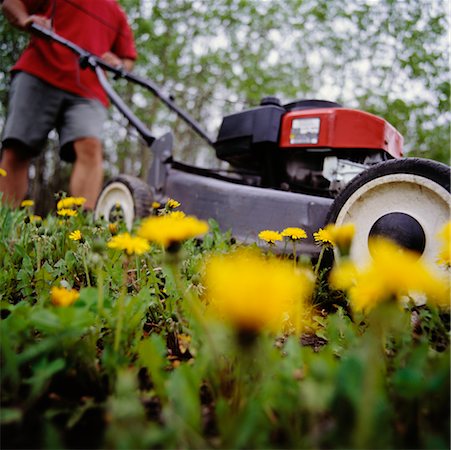
Yay or Nay to #NoMowMay?
The campaign was designed to feed pollinators, but long grass causes more problems! We dive into where it originated, what makes sense, and recommendations based on science.
The fresh growth of spring means the return of the #NoMowMay campaign encouraging homeowners to let their grass grow longer to help insect pollinators. As the experts in grasses, we’ve been asked by the public and media to weigh in with our opinion.
Is No Mow May a bad idea?
We feel that this a great campaign for starting a conversation about supporting our pollinators. However, it is a little misguided. Many early-flowering weeds that can be found in lawns, such as dandelions, are actually an incomplete source of nutrition for pollinators.
“Dandelions aren’t going to save the bees,” says Dr. Eric Lyons, associate professor at the University of Guelph. “A much better nutrition source for them are flowering trees, like crabapple, choke cherry and even maple, oak and willow.”
This is echoed by the Nature Conservancy of Canada in a news release in 2022.
“We are suggesting they use native plants – trees and flowers – in their yards to have a lasting impact. Many plants bloom before dandelions and are more nutritious.”
-Andrew Holland, NCC national media relations director
What’s more, creating temporary habitats in the form of an overly long lawn is not helpful to pollinators if the plan is to eventually mow the grass into a lawn. Plant pollinator-friendly flowers, grasses and shrubs instead. If you feel very motivated to support pollinators, you could create wildflower zones in home gardens with pollinator-friendly grasses and shrubs to benefit insects and wildlife all year round. Note that these areas can attract all kinds of biodiversity, even some of the pests that we don’t like (fleas, ticks, mosquitos) so we recommend putting these “Naturalized Zones” in an area away from children and pets.
From a turfgrass perspective, “No Mow May” can harm the home lawn.
“Allowing lawns to grow long can encourage the growth of undesirable weed species such as thistles, prostrate knotweed and wild violet, which are difficult to remove once they become established. It will likely take more inputs of water, fertilizer, seed, and herbicides to get your lawn back into shape after a #NoMowMay.”
-Dr. Sara Stricker, Guelp Turfgrass Institute Communications and Outreach Coordinator
Cutting too much of a grass’s length at once is also traumatic, leaving the grass with a sudden loss of an energy source during an active growing time. Tall grass is also difficult to mow, which can increase the risk of “scalping” the turf, making the lawn more susceptible to insects, weeds and disease.
“We recommend mowing home lawns when the grass reaches approximately three inches high,” said Lyons. “Grasses have evolved to be grazed upon by herbivores, so they actually respond positively to mowing practices.”
-Dr. Eric Lyons, Professor at the University of Guelph
The #NoMowMay campaign has gone viral because of its simplicity. Do nothing = support environment. Unfortunately, conservation efforts are rarely so simple. Talk to your local garden centre about which plants are best for your region, and which are native in your Hardiness Zone. In general, planting perennials is recommended since they will come back every year (easier for you to maintain) and it reduces on shipping/manufacturing inputs.
#MowWhenYouGrassNeedsMowing doesn’t have the same ring to it, but perhaps we can promote #PlantNatives instead?
However you decide to manage your property, take into account the function of the space. If you want a garden of flowers, then you can create that. If you want a functional space for events, play, or exercise, grasses are the most resistant to wear-and-tear and foot traffic.
Infographic Posters
Download this handy poster on #Know2MowMay to print or share electronically.
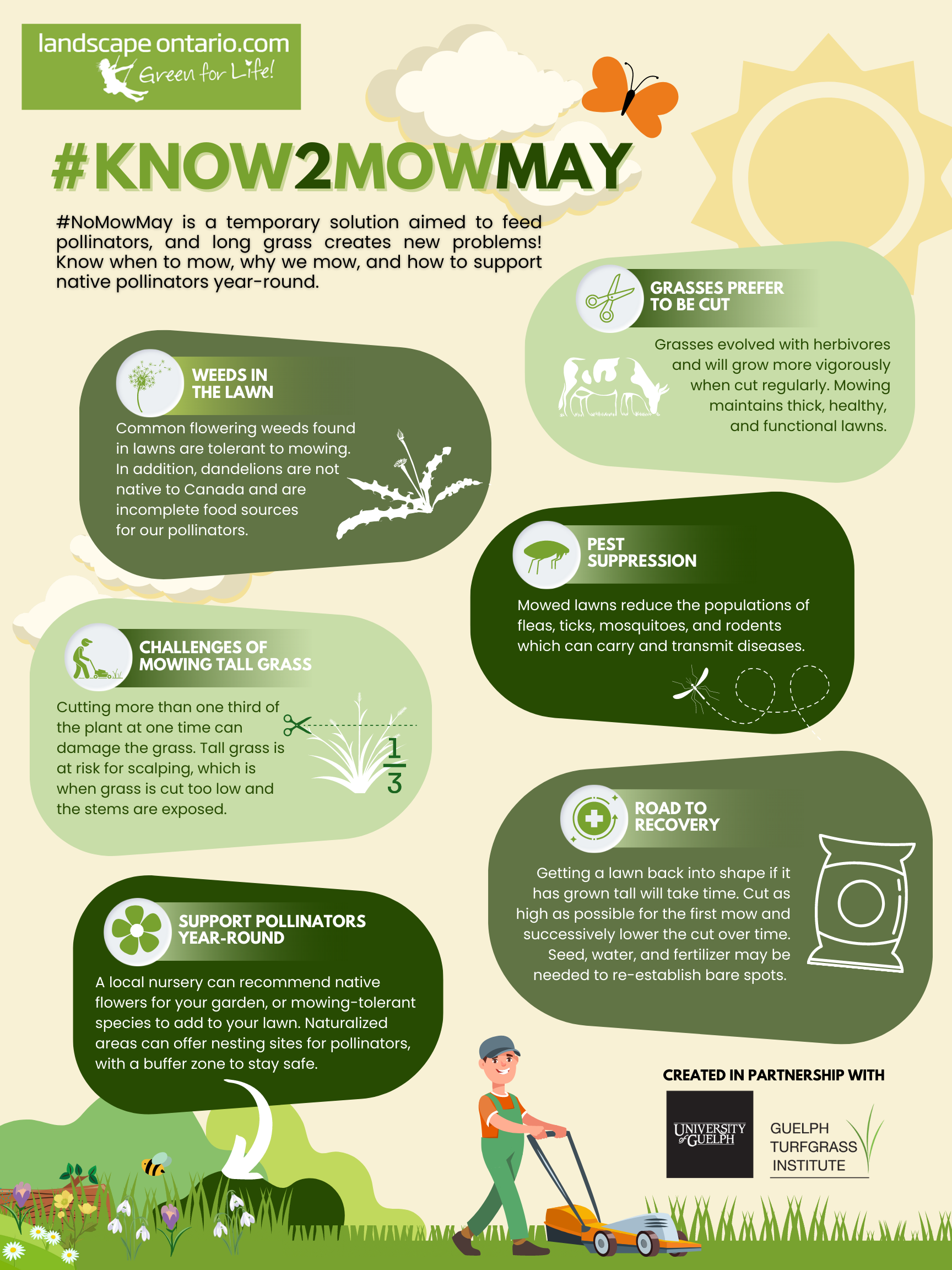

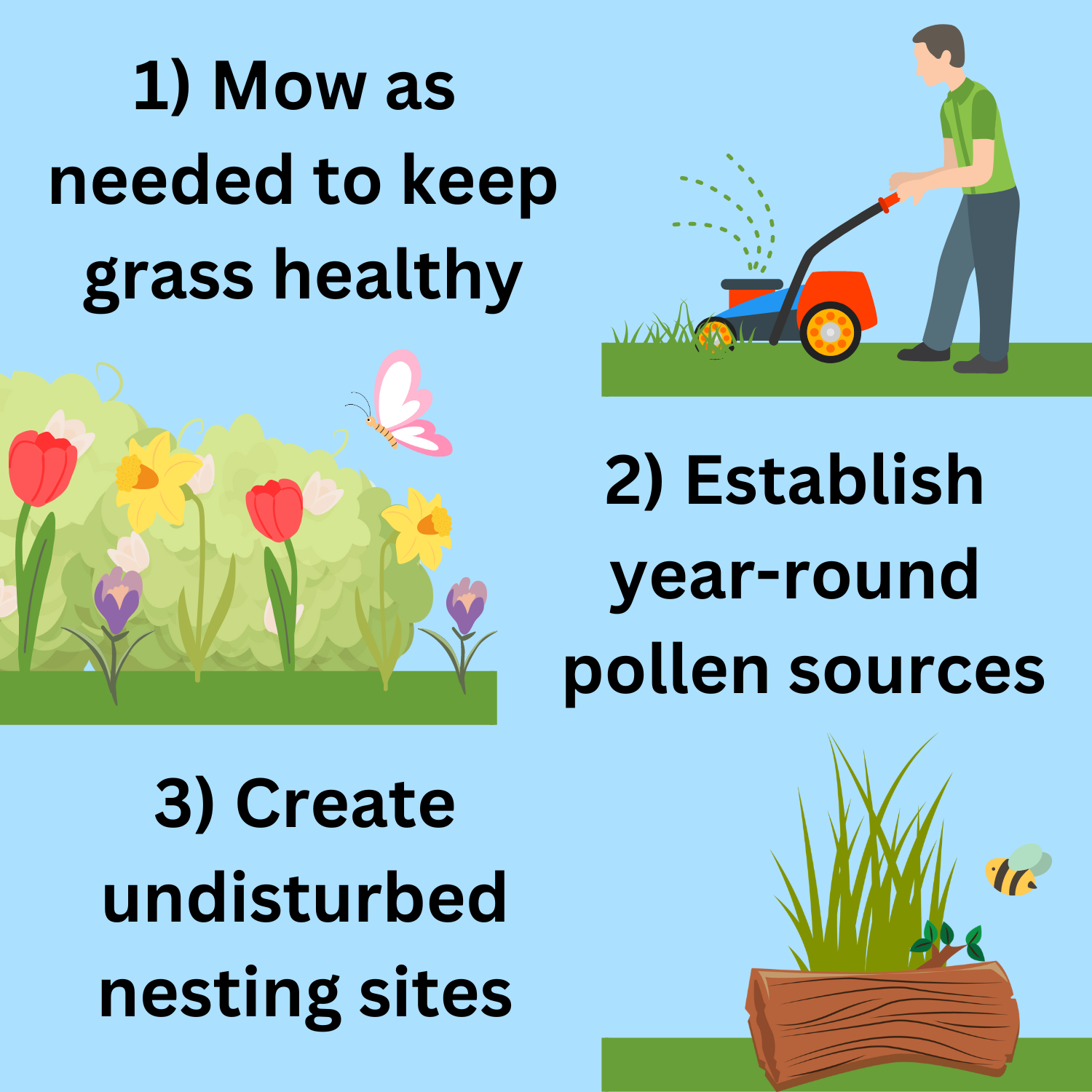
How to revive your lawn after winter and avoid long-lasting damage: experts
by CTV Toronto, Ontario, 2024
- The first step is to clear the debris left by the winter conditions.
- Hand-weeding and proper fertilization will also help.
- On #NoMowMay: Consider getting a flower pot,” Stricker said. “Your lawn grows best when it’s cut regularly, based on its growth rate.”
- Raise the mower deck higher to let your grass grow longer as taller grass has deeper roots and you can also set your mower to mulch as the clippings provide nutrients to your lawn.
Does No Mow May work? Here’s what experts had to say
by Jesse Leavenworth, New Haven Register, Connecticut USA, 2024
- People who maintain their grass to golf course perfection are not helping pollinators by postponing mowing in May
- A low-mow regime is generally beneficial for pollinators and allows more native flowers
- Grass will no doubt get shaded by tall weeds, and weeds and invasive plants that take hold during the month won’t simply disappear once the mowing commences. That might lead people to apply chemical pesticides they wouldn’t otherwise use.
- Hopefully this campaign inspires people to allow at least part of their yards go fallow and to plant more flowers that attract bees, butterflies and other pollinators.
Pollinator assemblages on dandelions and white clover in urban and suburban lawns
by Larson et al., 2014, Kentucky USA
- 50 different pollinator species visited dandelions and clover mowed at 6.4–8.9 cm (2.5–3.5″) every 7 to 10 days
- White clover attracted Western honeybee (Apis mellifera), dandelion attracted syrphid flies (Syrphidae)
- Species richness of bees on white clover was similar in urban, suburban, and periurban-rural lawns
- Syrphidae tend to favor open, shallow flowers (like dandelion) whose nectar and pollen are accessible to the flies’ relatively short mouthparts
- Long-tongued bees tend to avoid shallow flowers that offer only a small amount of nectar per flower, preferring plants that offer more energetically-advantageous floral rewards like clover
- White clover is better suited than dandelion for bee conservation lawns
To mow or to mow less: Lawn mowing frequency affects bee abundance and diversity.
by Lerman et al., 2018, Massachusetts US
- Lawns mowed every three weeks had as much as 2.5 times more lawn flowers compared to mowing every week, or every other week
- Lawns mowed every two weeks supported the highest bee abundance
- Mowing less frequently is practical, economical, and a timesaving alternative to lawn replacement or even planting pollinator gardens
- Grass in this study was cut to 6.35 cm. The height of the grass in each mowing frequency was approximately 11.2 cm (1 week), 12.5 cm (2 week), and 15.cm (3 week)
Lawn mowing frequency and its effects on biogenic and anthropogenic carbon dioxide emissions
by Lerman & Contosta, 2019, Massachusetts USA
- In lawns, carbon dioxide is emitted by soil respiration due to microbial activity and by fossil fuel burning.
- Mowing frequency (7 days, 12–14 days or 18–21 days) did not consistently change soil moisture, temperature, and soil respiration.
- Carbon dioxide emissions from soil microbes were: 482 g/m² s ( weekly), 436 g /m² (every other week), 458 g/m² (3 week) – no significant differences between treatments,
- Carbon dioxide emissions from mowing by frequency were: 16.3 g/m² s( weekly), 10.7 g /m² (every other week), 6.9 g/m² (3 week)
- Although mowing time might be shorter when using a rider mower, rider mowers emit more than four times as much CO2 compared to a push mower
- Increasing tree canopy cover in lawn-dominated yards and replacing some lawn with other vegetation that requires less intensive maintenance can reduce carbon dioxide emissions
From urban lawns to urban meadow: Reduction of mowing frequency increases plant taxonomic, functional and phylogenetic diversity
by Chollet et al., 2018, France
Important note: this study applies to grasslands 5–10 ha in size (50,00- 100,000 m², 12–24 acres)
- Mowing frequency is 15 –20 times per year in highly managed grasslands, 7–9 time per year in intermediate, and once per year in low managed grasslands.
- The low mowing frequency presents a higher plant diversity compared to the high mowing frequency grasslands
- The intermediate mowing frequency failed to produce any increase in plant diversity
- Frequent mowing selects for disturbance-tolerant pioneer species and grasses
Local garderning practices shape urban lawn floristic communities
by Bertoncini et al., 2012, France
- The location of the lawn in a public green space, foot traffic, frequent mowing, and use of pesticides reduced ecological biodiversity
- Persian speedwell (Veronica persica), heal-all (Prunella vulgaris), English daisy (Bellis perennis) are a mowing tolerant flowering plants commonly found in lawns
- Location and use altered the type of weeds in the lawn: Large lawns that are distant from the urban centre favoured the establishment of perennial species that are pollinated and dispersed by wind. Frequently mown lawns mostly hosted species that are tolerant to mowing and trampling and able to reproduce sexually and asexually. Small, rarely mowed lawns, situated near the urban centre supported communities of annual species that are self-pollinated and intolerant to mowing and trampling.
- Green areas are important for people living in urban areas, so it is necessary to find practices that can reconcile the presence of the public use and biodiversity management.
Partial mowing of urban lawns supports higher abundances and diversities of insects
by Wintergerst et al., 2021, Germany
The size of lawns/meadows in this study ranges from 815 m (0.2 acre) to 3460 m (0.9 acre), mowed 0-5 times per year.
- Some mowing (1-3 times/year) is required in order to prevent a meadow from becoming fallow ground.
- The reduction of mowing frequency extends the time window during which plants and insects can develop, leading to higher biodiversity.
- Every time an area is mowed, a part should be left uncut (about 30%). The uncut area rotates with every mowing event in order to prevent fallow.
- Tall grass areas or meadows are essential for insect overwintering
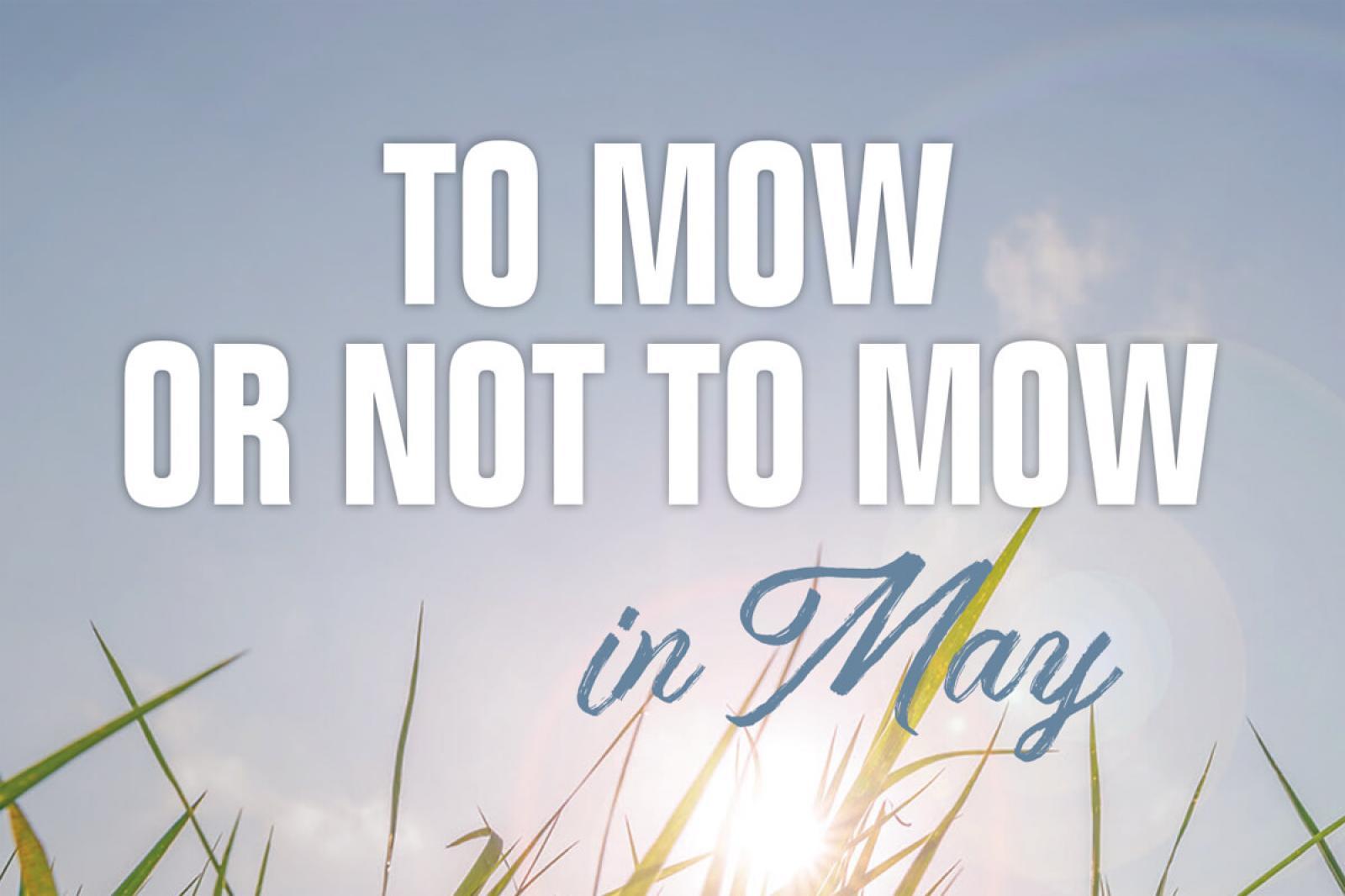
To mow or not to mow in May
by Dr. Sara Stricker and Dr. Eric Lyons, Guelph Ontario, 2023
Read the full article In Landscape Ontario Magazine
No Mow May? Yeah, maybe not, says University of Guelph expert
by Tyler Clarke, Collingwood Today, Collingwood Ontario, 2023
Sara Stricker, communications and outreach co-ordinator for the Guelph Turfgrass Institute at the University of Guelph, has been reaching out to media outlets in recent weeks advocating against people letting their lawns grow long during the month of May for pollinators
No Mow May – Does it Work?
by Garden Fundamentals, Robert Pavlis, Ontario, 2023
- #NoMowMay began along roadsides in the United Kingdom – very different than lawns in North America
- Lawns that have been treated with herbicides will not create flowers for pollinators
- In Ontario, the most abundant pollen source is native trees
- Extremely high grass actually has fewer flowers
- Cutting high grass can stress out the lawn
- There’s no long-term benefit to #NoMowMay
No Mow May Results and Feedback
by Liz Zorab, Byther Farm, United Kingdom, 2023
- Think about your “exit strategy”: how to cut long grass and dealing with weeds that are setting seed.
- If you are expecting to return your lawn to “bowling green beauty”, you’re going to be sorely dissappointed. Think carefully about what you really want your lawn to be.
- If you want a functional lawn, have a mowed area.
- If you have a very small yard/garden, then #NoMowMay doesn’t make sense. Add flowers to your borders rather than allowing your lawn to grow long – after all, children need an area to play
- We are cutting most of it, and letting the corners and the edges grow long to allow for wildflowers.
- Manage weeds (like docks) to prevent them from going to seed
- Give #NoMowMay a try, but be prepared to adapt and change your practices in the future
‘No Mow May’ not all it’s cracked up to be, says Peterborough gardening expert
by Global News, Ontario, 2023
- We have a lot of growth in May, and I can’t imagine how difficult it would be to get my grass back into a “lawn state” in June
- Dandelions are a food source for some pollinators, but they are not native and they are not a great food source
- Better food sources for pollinators include trees, hyacinths, crocus, and daffodils. Most of those pollen sources live in gardens in wild areas, not lawns
- 350,000 varieties of pollinators exist, so we should plant native species that they are looking for
- Adding clover to a lawn can provide pollen, and can be an alternative to grassy lawns if you have a white grub infestation
Why grass experts say No Mow May might be a bad idea for local lawns
by CTV Kitchener and Guelph Turfgrass Institute, Ontario, 2023
- Self-shading can occur when grass grows too tall
- The Nature Conservancy of Canada agrees that dandelions are not a great source of pollen
- #NoMowMay increases the risk for weeds and makes it harder to maintain the lawn for the rest of the year
- Plant flowers to support pollinators. Clover can be added to a lawn and mowed.
- Months that are hot and dry (like July) are when mowing is not needed
New research has scientists re-thinking the popular No Mow May Idea
by KARE 11 with University of Minnesota’s Turfgrass Extension Educator, John Trappe, USA, 2023
- Research from Wisconsin initailly supported the #NoMayMay movement, but has since been retracted
- We don’t know for sure if there are positive effects on pollinators, but we do know that there will be some negative impacts on our lawn.
- Grass grows excessively during the spring, and the clippings from mowing in May provide nutition and water-holding capacity to survive drought in the summer.
- Mowing in June will create excess clippings, these will liekly be bagged and removed from the lawn – a practice that is not recommended
- Mowing tall grass can create an extreme volume of clippings, which could smother the turf
- Create a “bee lawn” – yarrow and self-heal can be seeded into lawns (in Wisconsin) as food for pollinators that can also be mown
The PROBLEM with No Mow May
by Naturally JB, United Kingdom, 2022
- The advertisements for #NoMowMay show amazing meadows bursting with colour and wildflowers, but that is an unrealistic expectation for a typical home lawn
- People try it, end up with tall grass, and have a tough time mowing it back into a lawn afterwards
- If you really want to create nectar resources for pollinators, it takes time.
- There is biodiversity in a lawn if you alter your expectations and allow plants typically thought of as weeds to establish
- Create structural diversity in your yard – shorter grass, taller grass, and flowers.
- Wildflowers are not accustomed to fertilized lawn areas – recommendations for changing the lawn to a wildflower garden are provided.
Bee Lawns and Slow Mow Summer
by Angie Hong, East Metro Water, Minnesota USA, 2023
- The best action to support pollinators and other wildlife is to plant native trees, shrubs and flowering plants
- Replacing some turf with native plants also helps to create pockets of habitat, improve soil health, and reduce environmental impacts from mowing, watering, pesticides and fertilizers.
- #NoMowMay is the ecological equivalent of opening a fast-food restaurant on every corner – for a short amount of time.
- People can provide better forage for native bees by enhancing their existing lawns with flowering species
Mow your lawn or not? That’s the debate for May
by Leah Gerber, The Observer Newspaper, Elmira Ontario
- We’ve seen a really warm spring, so the grass is growing and it needs to be mowed
- Our grass is designed to be mowed and it’s healthiest when it’s mowed regularly.
- Lawns have a purpose in urban settings
- A better option than not mowing, she says, is to set aside a portion of the property to be solely dedicated to being naturalized and left for pollinators.
- Not mowing in the month of May or reducing the frequency of mowing is better for pollinators than doing nothing
- Flowers considered to be weeds that first come up, like dandelions, do not have as much pollen, their abundance makes up for that
- Leaving leaf piles and hollow stems over winter creates nesting sites for cavity-nesting bees
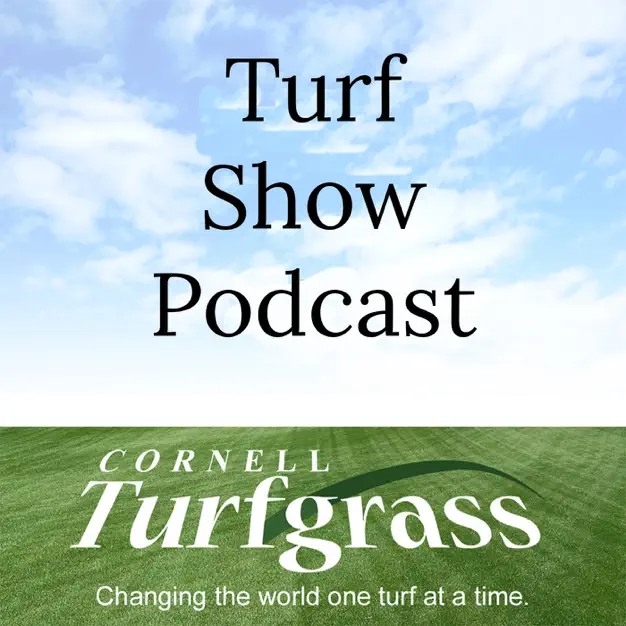
Season 4, Episode 12 (lawn and landscape): No Mow May - Yay or Nay?
by Dr. Frank Rossi at Cornell University
- Lawns can offer ecosystem services to pollinators, but we need to think differently about them.
- Minnesota offers rebates in your incorporate flowering species into your lawn – but a more diverse ecosystem means you might need to change your management practices.
- Reducing mowing frequency will reduce fossil fuel use. For example, the “Tall Grass less Gas” project.
- Increasing mowing height can allow for flowering plants with prostrate and creeping growth habits to survive in lawns.
- Snakes might inhabit long grass.

What is the optimal mowing height and frequency for lawn-height turfgrass?
by Glen Obear, D.J. Michael, Bill Kreuser, Ph.D. at the Department of Agronomy and Horticulture, University of Nebraska-Lincoln
Note: This was conducted on irrigated tall fescue stand.
- Mowing to the 1/3rd Rule (33% mowing threshold) resulted in acceptable lawn quality with no scalping and fewest mowings compared to other treatments.
- Mowing to the 50% threshold caused some scalping, but can be an option for lower maintenance lawns.
No Mow May, Low Mow Spring
by Bee City USA
- Re-thinking the American lawn can take a variety of forms from reducing mowing frequency or area mown to permanently converting lawn to a more diverse and natural landscape.
- Floral resources may be hard to find, especially in urban and suburban landscapes. By allowing it to grow longer, and letting flowers bloom, your lawn can provide nectar and pollen to help your bee neighbors thrive.
- You don’t need to go a full month without mowing. Mowing every two or three weeks can increase flower blooms and provide food for hungry bees.
I am participating in No Mow May
by Blue Marble Learning Scene
- If you want grass to grow in your yard then no mow May is not going to help. If you consider “weeds” to be bad then again, no mow May is not for you.
- When (lawns are) left to grow throughout May, flowering plants have a chance to flower. Regardless if the flowers in your yard are complete food sources or not, any food is better than nothing for our pollinators.
- Pollinator gardens and more flowering / fruiting trees are better, but as we work towards this, no mow May will help.
- The choice to participate or not is up to each of you and we hope that everyone can move forward respecting individual decisions on this topic.
No Mow May? Good intentions, bad approach, critics say
by Jessica Damiano, AP News
- Some of those pollinators you set out to protect will likely get shredded up with the first mow of the season
- Weeds and invasive plants that take hold during the month won’t simply disappear once the mowing commences. That might lead people to apply chemical pesticides they wouldn’t otherwise use.
- “It’s such a nice slogan, but letting the grass grow high and allowing it to do its thing, and then suddenly mowing it back is really counterproductive” says Tamson Yeh, turf specialist with the Cornell Cooperative Extension of Suffolk County.
- Yeh cautions that “allowing grass to go to seed will kill it,” so remove seedheads if they form.
The surprising downside of #NoMowMay
by Sheila Colla, Rewilding Magazine, Canada
- Not cutting your lawn and letting dandelions grow for a month is touted as an easy way to help bees. But one-size-fits-all solutions don’t work for conservation.
- A month of long lawns filled with dandelions and other non-native weedy species doesn’t create biodiversity and ecological integrity.
- Manicured, monocultural lawns are pollinator deserts – the less lawn the better. Replace part of your lawn with densely planted native plants if pollinator support is your main goal.
What’s the deal with “No Mow May?”
by Hannah Gaines Day, Claudio Gratton, Julie Hill, Paul Koch, Kristin Krokowski, PJ Liesch, Madisen Potratz, Mark Renz, Tim Ripp, Doug Soldat at University of Wisconsin-Madison, USA
- Lawns that are mowed higher (more than 3”) and less often tend to have more flowering plants, supporting a greater diversity of pollinators and other insects
- Low-growing flowering plants like Dutch White Clover (Trifolium repens), Self-heal (Prunella vulgaris) and Creeping Thyme (Thymus serpyllum) will add diversity to the flowering plants in your yard and can tolerate mowing and some foot traffic.
- If you are worried about being stung, plant away from high traffic/play areas.
- Delay your spring clean-up and/or tilling of these places until late spring (late May) after pollinators have emerged as adults from their overwintering nests.
- Learn more about how to provide shelter and nesting habitat for pollinators: Xerces Society’s Nesting and Overwintering Habitat publication.
No Mow May: A Gateway to Better Landscape Management for Bees
by Matthew Shepherd and Laura Rost, Xerces Society for Invertebrate Conservation, 2023
- The benefits from not mowing for a few weeks are limited.
- Letting dandelions and other weeds bloom is not good quality habitat—and any benefits will be canceled if you mow it all in June.
- People want a place where they can throw a ball, their dog can run around, they can sit with friends on a summer evening. All of those things can be done with a flower-filled lawn; you may just have to raise the cutting height and mow less frequently.
- There is no one-size-fits-all approach to No Mow May and it must be adapted to local conditions—weather, vegetation, and people.
No Mow May
by Credit Valley Conservation, Ontario, 2022
- Add diversity and a splash of colour by allowing low-growing plants like wild strawberry, strict blue-eyed-grass and common silverweed to spread throughout your lawn.
- Extend garden beds or create new ones.
- If your lawn doesn’t have heavy foot traffic, you can create a beautiful tapestry lawn of different colours and textures by planting masses of native ground covers, like Pennsylvania sedge, common blue violet and wild ginger.
No Mow May
by the University of Minnesota Bee Lab, 2023
- Early spring blooming native plants like violets and pussy toes can be a part of your bee lawn
- For blooms in your lawns after May, add self-heal, ground plum, lanceleaf tickweed, or calico American aster.
- Leaving your leaves where they are until temperatures are above 50 degrees F (10 °C)for 5 consecutive days will give most of those hibernating pollinators the protection that they need.
- If you have an out of the way corner in your yard where you can make a pile of thatch, that could make great habitat for some bees.
- Rusty patched bumblebees are underground and are not affected by mowing, even when their nests are active.
- For some species like white clover, you may need to mow in May to encourage them to flower again if the flowers are going to seed.
No Mow May: Is it a good idea?
by the Garden Professors: Abiya Saeed, Extension Horticulture Specialist at Montana State University, 2023
- Although the intention behind this campaign is a good one, providing food for pollinators, there are some aspects of this initiative that seem to miss the mark.
- Bees and other pollinators will forage on dandelions especially if other floral resources are unavailable at that time.
- If left unmown: your turfgrass will soon outgrow any other flowering lawn weeds which can make them difficult to find for pollinators, and that is if these flowering lawn weeds aren’t smothered by the tall grass altogether.
- In many places, lawns can grow a foot or more during the month of May. An un-mown lawn can set you back on your lawn maintenance and result in more work for you in the long run.
- If you have flowering lawn weeds and pollinator conservation is your intention, your best bet would be to aim for a sweet spot between the extremes of mowing way too frequently and not mowing at all.
Neighbors Fight Over No Mow May: ‘What in the World Is Happening in This Place?’
by James Hagerty, Wall Street Journal, Pittsburgh USA, 2023
- NoMowMay puts bees in the bonnets of some people – some neighbours hate the shaggy appearance of some lawns.
- NoMowMay led to increased signtings of woodchucks, racoons, and snakes in St. Peter Minnesota.
- Some people have recieved citations and fines for letting grass grow too long.
- Dr. Doug Tallamy from University of Delaware sees little logic in letting lawns grow longer for a few weeks. This is a tease to pollinators with short-term snacks.
- Homegrown National Park urges homeowners to keep lawns mowed and plant native flowers in gardens.
- Dr. Del Toro’s paper supporting NoMowMay was retracted, but they aim to amend and resubmit it.
Is the science behind an initiative to naturally grow your lawn flawed?
by Dr. Torah Katchur, CBC Radio One, Edmonton and Guelph Turfgrass Institute, Ontario, 2023
- Trying to apply a campaign (designed in UK) across all of Canada does not make sense
- Cutting a grass down after #NoMowMay can result in scalping, thus damaging the lawn
- Leave some leaves in your back yard (in corners and under trees) to allow pollinators to overwinter – rake leaves off the lawn so you don’t smother the grass – but allow pollinators to overwinter until the threat of frost has passed
- Mulch leaves over the lawn – it acts as fertilizer
- Plant a strip of wildflowers, or add crocus/snowdrop into your lawn
- Turn lights off at night to support moths
- Avoid pesticide use to support beneficial insects
- Creating naturalized prairies/meadows is recommended in rural areas
No Dandelions in Long Grass
TikTok by Angie Hong, East Metro Water, Minnesota USA, 2023
- Several dandelion flowers are seen in the mowed section of a roadside.
- In the tall grass, no dandelions are seen.
- Dandelions grow best in lawns, disturbed areas, or along trails
No-Mow May: feel-good movement or selfless sacrifice for pollinators?
by Hannah Rudderham, CBC News, New Brunswick, 2023
- Sara Stricker, a turf researcher at the University of Guelph, says leaving the lawn to grow might not be the best course of action for these species.
- “It’s a catchy hashtag … You make cute banners, you know, ‘pardon the weeds and feeding the bees’ or something like that. It’s a feel-good movement,” Stricker said.
- Andrew Holland with the Nature Conservancy of Canada, based in Fredericton, agrees. He said dandelions are not that nutritious for pollinators and they prefer native plants and shrubs as a food source
- Stricker said people shouldn’t judge their neighbours for wanting to mow their lawns. Similarly, Holland said people also shouldn’t judge those who don’t have short, trimmed and “pristine” lawns.
Just Say No to No Mow May
by Monarch Gardens, 2023
- Just letting your lawn go will not result in a lovely meadow that neighbours or wildlife will admire
- What happens when you let your lawn go or stop mowing?
- It’s going to look weedy fast.
- Invasive species may establish.
- Woody plants will move in. Without constant management tree seedlings will start to grow.
- It’s better to design the space, to choose the plant communities that will work together AND support wildlife.
by University of Minnesota Bee Lab, 2023
Jon Trappe, James Wolfin, Elaine Evans, Aaron Irber, Ben Ziegler
- May is often the time for high growth rates of turfgrass (in MN)- possibly reaching 12″ by end of April if not cut.
- Cutting too much at one time is stressful to turf, and can lead to bare soil – increasing risk of erosion.
- Low-input turf species (fescues) require less mowing, fertilizer, and water.
- Excess clippings after NoMowMay need to be remoevd (to avoid smothering) which removes nitrogen – this can result in increased synthetic fertilizer use later in the season.
- If turf produces seedheads (due to lack of mowing) then the plant will be extremely stressed upon mowing.
- Raise the mowing height for a healthier lawn, which will also allow for small flowering plants.
- Never mow more than 1/3 of the turf plant in one cutting. Mow when the lawn needs it (not based on the calendar).
- A garden with native flowers, trees, and bushes can be designed to provide year-long flowering periods.
- Bees need habitat and flower resources all year.
- Bees commonly found in MN study in a community garden included honeybee, sweat bee, common eastern bee, yellow-faced bee, and eastern cucurbit bee. These mostly visited wild chive, field pumpkin, coriander, spearmint, oregano, dill, field mustard, ground ivy, dandelion, and fleabane.
- Tips for a bee lawn also included!
by the Middle-Size Garden, United Kingdom, 2024
- Has done #NoMowMay for the past 3 years and shares personal insights
- Avoiding mowing for a few weeks does not spontaneously generate a wildflower garden.
- NoMowMay did not catastrophically damage the lawn, although stress is evident directly after the first mowing
- If you live in areas prone to wildfires, long grass is not recommended.
- Lawns provide beneficial environmental services in urban areas, especially when under low-input management.
- Ground-nesting Ivy Mining bees nest in sandy soils and need access to short-cut turf from Sept-Nov.
- Think about what you need from your lawn – if your lawn is a playground for kids, then #NoMoMay doesn’t make sense.
- Think about creating “corridors” between existing habitats in your environment.
Does No Mow May Really Help Pollinators?
by Megan White and Melimda Myers, Birds&Blooms,Wisconsin USA, 2024
- The pollinators that enjoy the unmowed lawn will likely return later, only to find their food sources are gone.
- If your city has a limit on grass height, try talking to the city council about exemptions.
- It could be difficult and detrimental to tackle the immense growth at the end of the month. Lower the height of your grass slowly over several mows.
- Try pocket planting, which, as the name implies, is the practice of creating smaller areas with specific vegetation.
- If you have the room and freedom and are ready to put in more effort, consider meadowscaping.
No Mow May to return after complaints in 2023
by Josh Sandiford, BBC News, United Kingdom, 2024
- Last year was the first time the council supported this initiative and feedback received from residents has been used to guide the initiative this year
- Council housing estates, children’s play areas, sports pitches and cemeteries will be excluded and the council will continue to mow these locations.
Should you do No Mow May? The pros and cons…
by the Middle-Sized Garden, United Kingdom, 2024
- No Mow May is an opportunity to find out what living with a less-than-perfect lawn might be like.
- In some places, growing your lawn grass longer is not permitted.
- If you have children who play on your lawn, then NoMowMay is not for you.
- A lawn absorbs rainwater and helps stops urban drains from flash flooding. It also absorbs heat, pollution and carbon dioxide, and provides a home for worms and soil micro-organisms.
- You won’t get a lawn full of beautiful wild flowers in one ‘No Mow May’. If you do want a meadow lawn with wildflowers, you will have to actively create one.
- You place the lawn under strain by letting the grass grow long, then chopping it very short in one day.
- The author did not find ticks in their un-cut lawn, but advises you should be ‘tick aware’ regardless of what you decide to do with your lawn.
Does ‘No Mow May’ really help pollinators?
by the World Wildlife Foundation, 2024
- Skipping May mowing lets some flowers spring. This is great for “generalist” insects that aren’t too specific about what species of flowers they feed from, like the bicoloured sweat bee
- There are even better ways to help pollinators and other wildlife.
- Raise the blades on your mower and cut less frequently
- Instead of a “wall-to-wall” carpet of turfgrass, replace part of it with a garden filled with native species.
by Wild Your Garden with Joel Ashton, United Kingdom, 2024
- When we get to the end of May, you will mow down the grass and remove the resources and the wildlife that has moved in.
- Small animals like hedgehogs can be at risk when mowing down tall grass.
- Providing year-long habitats and food sources is a better solution than #NoMowMay
- Butterfly species will lay eggs on grass in June in the UK, so cutting tall grass down can “wipe out a generation. Create meadow-like areas which will be naturalized with one mow per year.
- Create a mosaic of habitats to support biodiversity, including mowed grasses.
- No Mow Summer makes more sense (more pollinators are active and growth rate of grass is lower).
by Cornell Turfgrass Show 2024: Episode 6 with Dr. Frank Rossi and Carl Schimenti from Cornell University and Dr. Sara Stricker from University of Guelph. New York, 2024
- Turfgrass grown in early May is crazy in this region. Lawns could be mowed multiple times per week.
- People are googling “NoMowMay” on the second week of May – 2023 showed more Google searches in New Year than in 2022.
- Society is encouraged to rethink the function of their lawn – exercise “slow mow summer” or plant a “bee lawn” if the lawn is not in high-use.
How beneficial really is “No Mow May”?
Ongoing conversation on iNaturalist.org (cited from May 2024)
- People thinking that a couple of weeks of dandelions and non-native clover fixes the enormous habitat loss puts No-mow May very much into the “bee-washing” realm- Joel
- If your garden is situated in a more anthropized area you’ll mostly just get weeds, so sowing locally sourced wildflowers and manually eradicating invasives should be the first step. -Francesco
- Events like this are mostly educational opportunities. Folks can begin to get in touch with nature, and meet conservationists and scientists. – Astra
- I think No Mow May is useful and it helps start people thinking about alternatives. It’s a baby step, which some people and municipalities need. – Kami
- I do mow in May, but not “down” to the gras roots. Most wildflowers that grow in our lawn are more or less resistant to mowing. -Anne
The potential consequences of ‘bee washing’ on wild bee health and conservation
by S.R. Colla, International Journal for Parasitology: Parasites and Wildlife 18, August 2022, Pages 30-32
- Interest in conservation action to support pollinators has recently increased
-
Narratives tend to focus on actions which are easy to address but the species of concern is not a focus (like No Mow May)
-
Leading to misinformation, misallocation of resources, increasing threats and steering environmental policy away from evidence-based decision-making.
Crossing the Trans Canada Trail at 50 & Preparing Your Lawn
by Zoomer Radio (CFZM), Toronto, Ontario, 2024
with Dr. Katerina Jordan from the Guelph Turfgrass Institute
- Raking in spring is crucial to remove debris and allow light access for lawn recovery.
- Fertilization might not be immediately necessary; focus on raking and mowing initially.
- Overseeding can help fill in thin or bare lawn areas, using a suitable lawn mix for the environment.
- Mowing height recommendation is around 3 inches for optimal lawn health. Mowing using the “one-third rule” will help keep turf healthy.
- Aeration depends on soil quality and compaction; it’s recommended annually if soil is easily compacted.
- The “No Mow May” movement, while it could be beneficial for pollinators, may not suit those aiming for pristine turf.
- Lawns are useful for aesthetics and as a multi-use functional surface.

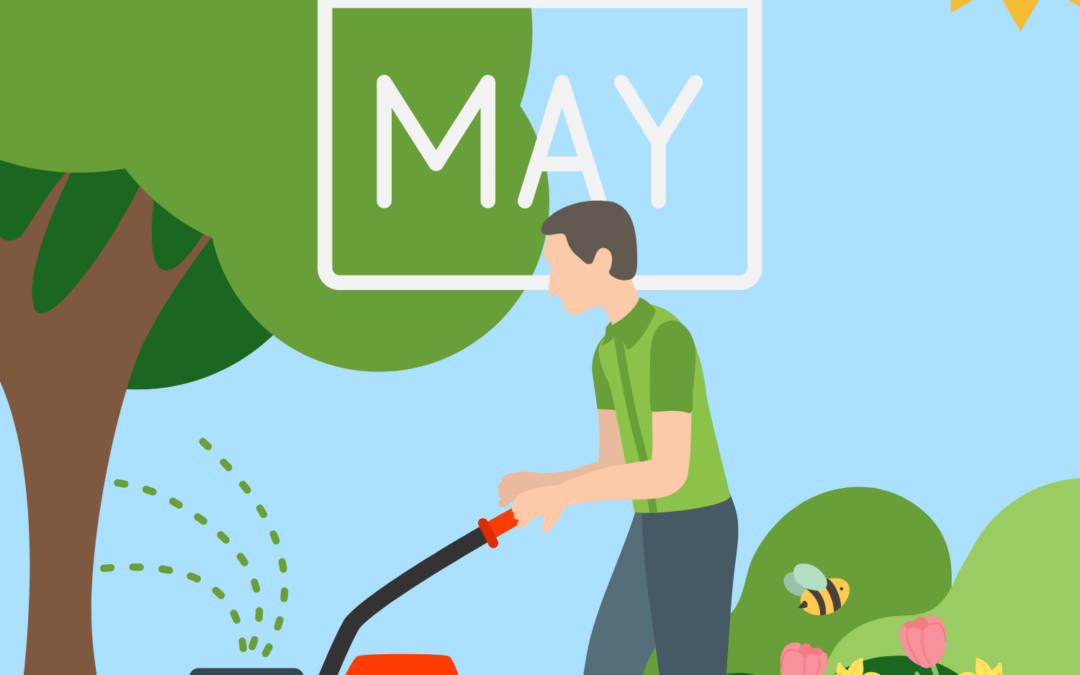
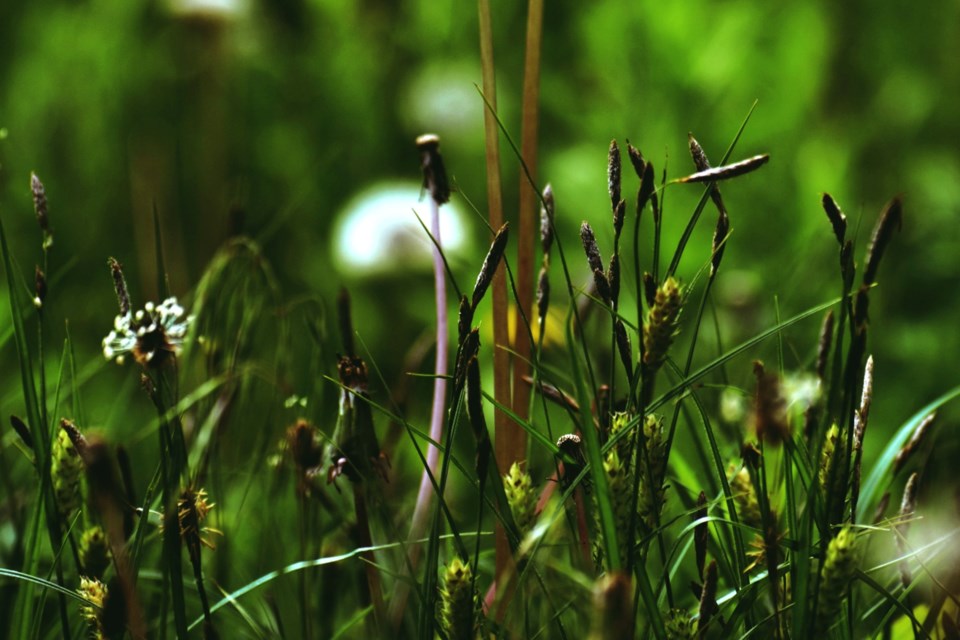
Sarah!
Great Website. I just found it today and want to collaborate!
We need more fact based lawn and sport turf campaigns!